 W
WAdhemarius gannascus is a moth of the family Sphingidae first described by Caspar Stoll in 1790.
 W
WAethria haemorrhoidalis is a moth of the subfamily Arctiinae. It was described by Stoll in 1790. It is found in Belize, Ecuador, Guyana, Surinam and Brazil.
 W
WAgrotis bigramma, the great dart, is a moth of the family Noctuidae. The species was first described by Eugenius Johann Christoph Esper in 1790. It is found from along the southern shores of the Baltic Sea to China, the Levant and North Africa. Migrants have been reported as far west as Great Britain with three in one trap at St Agnes, Isles of Scilly on 10 August 1997.
 W
WAntiblemma solina is a moth of the family Noctuidae. It is found in Neotropics.
 W
WCalyptra thalictri is a moth of the family Erebidae. It is native to the area ranging from Japan and Korea, south to China and Malaysia, west through the Urals to Southern Europe, but it has recently expanded its range to northern Europe. In 2000, it was observed in Finland and in 2008 it was recorded even further west, in Sweden.
 W
WCapsula sparganii, or Webb's wainscot, is a moth of the family Noctuidae. The species was first described by Eugenius Johann Christoph Esper in 1790. It is found in Europe, Central Asia, from southern Siberia to Manchuria, Korea, Turkey, Syria and Iran.
 W
WCatocala electa, the rosy underwing, is a moth of the family Erebidae. The species was first described by Karl Friedrich Vieweg in 1790. It can be found in Europe and Asia.
 W
WDrepana curvatula, the dusky hook-tip, is a moth of the family Drepanidae. It was first described by Moritz Balthasar Borkhausen in 1790 and it is found from Europe to Japan.
 W
WDrepana uncinula, the spiny hook-tip, is a moth in the family Drepanidae. It is part of the Drepana subgenus Watsonalla. It is found in France, Spain, Portugal, Italy and the western and southern part of the Balkan Peninsula. It was first described by Moritz Balthasar Borkhausen in 1790.
 W
WDyspessa ulula, the garlic mottled, is a species of moth of the family Cossidae. It is found from central and southern Europe through Russia to central Asia. It is also found in Syria, Iran, Iraq and parts of North Africa.
 W
WDysphania palmyra, the blue tiger moth or blue day moth, is a moth of the family Geometridae. The species was first described by Caspar Stoll in 1790. It is found in India and Sri Lanka.
 W
WEgybolis is a monotypic moth genus of the family Noctuidae erected by Jean Baptiste Boisduval in 1847. Its only species, Egybolis vaillantina, the African peach moth, was first described by Caspar Stoll in 1790. It is found in the Afrotropical realm.
 W
WElaphria venustula is a moth of the family Noctuidae. It is found in most of Europe, except the north. In the east, the range extends through the Palearctic to the Pacific Ocean.
 W
WEupithecia insigniata, the pinion-spotted pug, is a moth of the family Geometridae. The species can be found in Europe and Eastern Asia.
 W
WEvius hippia is a moth of the family Erebidae. It was described by Caspar Stoll in 1790. It is found in Mexico, Panama, Trinidad, French Guiana, Colombia, Suriname, Venezuela and Brazil.
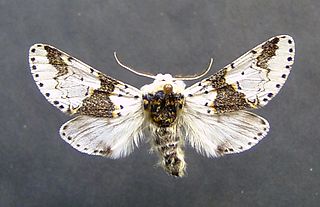 W
WFurcula bicuspis, the alder kitten, is a moth of the family Notodontidae. The species was first described by Moritz Balthasar Borkhausen in 1790. It is found in most of the Palearctic realm.
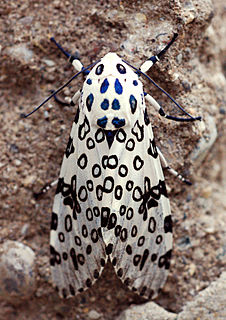 W
WThe giant leopard moth is a moth of the family Erebidae. They are distributed through North America from southern Ontario, and southern and eastern United States through New England, Mexico and down to Panama. The obsolete name Ecpantheria scribonia is still occasionally encountered.
 W
WGonodonta clotilda is a species of fruit-piercing moth in the family Erebidae. It is found in Central and South America.
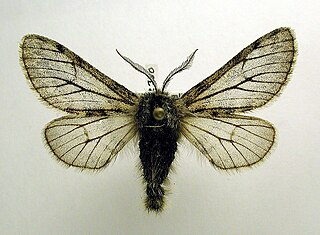 W
WLycia pomonaria is a moth of the family Geometridae. It is found from central and northern Europe through Siberia to the Kamchatka Peninsula.
 W
WMniotype adusta, the dark brocade, is a moth of the family Noctuidae. It was described by Eugenius Johann Christoph Esper in 1790. It is found throughout much of the Palearctic from Europe to Japan, China and Mongolia. It is also found in North America. The habitat consists of heathland, chalky downland, fenland, moorland and upland areas.
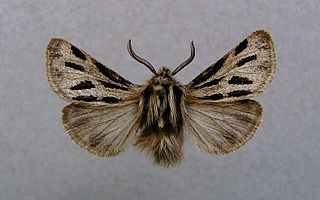 W
WOcnogyna parasita is a moth of the family Erebidae. It was described by Jacob Hübner in 1790. It is found in the Alps, the Black Sea region, the Balkan Peninsula, Asia Minor and southern Russia.
 W
WPhragmataecia castaneae, the reed leopard or giant borer, is a moth of the family Cossidae. It was described by Jacob Hübner in 1790. It is found in central and southern Europe, the Middle East, the Caucasus, Transcaucasia, Turkmenistan, Kazakhstan, north-western Iran, Iraq, Syria, Sri Lanka, Madagascar, India, Lebanon, Turkey, western China, south-western Siberia, Egypt, Tunisia and Morocco.
 W
WSideridis turbida, the white colon, is a moth of the family Noctuidae, subfamily Hadeninae. It is found throughout continental Europe, the British Isles and southern Scandinavia.
 W
WThe small square-spot is a moth of the family Noctuidae. The species was first described by Karl Friedrich Vieweg in 1790. It is found in Europe apart from the far south-east then east through the Caucasus, Transcaucasia, Central Asia, Siberia, the Russian Far East and Kamchatka.
 W
WStegania cararia, the ringed border, is a species of moth of the family Geometridae. It is found from France east to Russia. It is an immigrant in Great Britain. The habitat consists of damp forested areas.
 W
WSynanthedon stomoxiformis is a moth of the family Sesiidae. It is found in most of Europe and the Middle East.
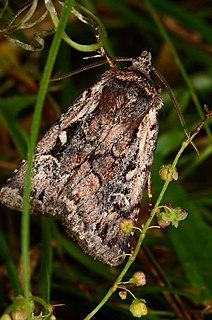 W
WXestia agathina, the heath rustic, is a moth of the family Noctuidae. It is found in western and central Europe and Morocco.
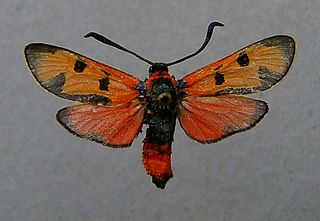 W
WZygaena laeta, the bloodword burnet, is a moth of the family Zygaenidae. It is found in Central and South-Eastern Europe.In Z. laeta the collar and patagia as well as the apical half of the abdomen are red: also the wings are testaceous red except some black spots on the forewing. Larva of light bluish green, with while dorsal and lateral lines, along which there are blackdots. Pupa yellow, anteriorly dark brown, in a whitish cocoon. The wingspan is 26–34 mm.
 W
WZygaena sarpedon is a moth of the Zygaenidae family. It is found in France, Italy and on the Iberian Peninsula.